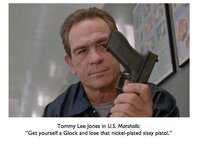Bronze Supporter
- Messages
- 2,168
- Reactions
- 4,912
There is no such thing as one ideal defensive handgun to rule them all because the intended purpose and personal preference dictate the required specs. Duty weapons or weapons that will not be concealed are often large-framed with the highest capacity possible. Weapons that will be concealed are generally a tradeoff between concealability (size, thickness), firepower (caliber, capacity), and ease of use (recoil management, trigger pull, manipulation, etc). It's about having the right tool for the mission at hand; none do everything well, so the ideal tool will vary.
Manual safeties are a double-edged sword. If carrying with the safety on, under stress the user may fail to disengage it. One must train to make the safety lever actuation part of the draw, which can be difficult depending on its location (frame-mounted safeties may be easier to switch during a draw than a slide-mounted safety). Either way, in a high-stress situation you want to have to rely on the least amount of fine motor skills possible.
I also don't see a value to the "render the gun safe if law enforcement asks you to drop it" requirement. If a cop wants you to drop the gun, the last thing they want is you continuing to manipulate it. Pistols are generally drop-safe, so don't worry about dropping it... unless it's a Sig

Manual safeties are a double-edged sword. If carrying with the safety on, under stress the user may fail to disengage it. One must train to make the safety lever actuation part of the draw, which can be difficult depending on its location (frame-mounted safeties may be easier to switch during a draw than a slide-mounted safety). Either way, in a high-stress situation you want to have to rely on the least amount of fine motor skills possible.
I also don't see a value to the "render the gun safe if law enforcement asks you to drop it" requirement. If a cop wants you to drop the gun, the last thing they want is you continuing to manipulate it. Pistols are generally drop-safe, so don't worry about dropping it... unless it's a Sig














